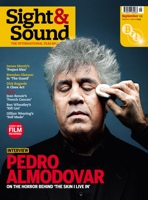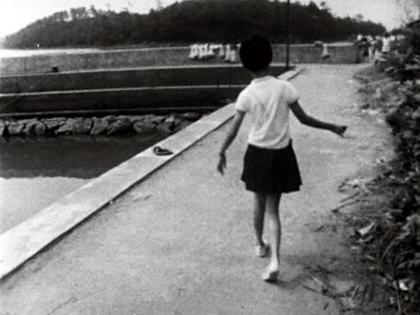Primary navigation


Tsuchimoto Noriaki’s films are immersed in the language, perceptions and environments of his subjects, says Chris Fujiwara
On the Road: A Document &
Minamata: The Victims and Their World
Tsuchimoto Noriaki; Japan 1964 / 71; Zakka Films / Region-free; 54 / 120 minutes; Aspect Ratio 4:3; Features: liner notes with essay by Abé Mark Nornes and film commentaries by Mizuno Sachiko
“To record the reality in front of me as truthfully as I could was the only way I could define myself,” said Tsuchimoto Noriaki (1928-2008), one of Japan’s greatest documentary filmmakers. The remark reveals not modesty so much as a tremendous integrity. Tsuchimoto’s cinema embodies a search for a point of view capable of representing the point of view of his subjects, and an immersion of the filmmaker’s subjectivity in the contradictions of his material.
A left-wing political activist in his university years, Tsuchimoto later joined a public-relations film production company, where his fellow directors included Hani Susumu and Ogawa Shinsuke. On the Road: A Document (1964, pictured above) was a breakthrough film – a study of the frustrations and worries of Tokyo taxi drivers as seen from the streets. Constantly imaginative and vigorous in depicting movement but never fetishising it in a facile or celebratory way, On the Road has the working-class speed and grimness of an early-1930s Warner Bros film, at the same time reshaping stray observational surprises in the manner of Beat poetry: a huge photograph of Romy Schneider looming sphinx-like over Christmas shoppers; the ticking of a clock dubbed over a shot of a blowtorch slowly working over the surface of a wrecked car; guys in the lunchroom passing round an X-ray of a colleague’s stomach as if it were the latest Playboy. The film establishes a hallmark of Tsuchimoto’s work: his closeness to the perceptions, language and environment of his subjects. It’s to them that the director attributed the liveliness of his film: “I’ve been told that On the Road is exciting, with various shots colliding in it,” he said in Fujiwara Toshi’s 2007 portrait Cinema Is About Documenting Lives: The Works and Times of Noriaki Tsuchimoto. “But they simply came from the words spoken by the drivers who were risking their lives on a daily basis.”
A turning-point in Tsuchimoto’s life and work came with his involvement in the struggle for recognition and reparation for the victims of an environmental disaster and a devastating neurological disease both known by the name of the fishing village of Minamata. From the 1930s, the Chisso Corporation had been dumping mercury-filled waste from its local plant into the sea; the mercury attacked the central nervous system of those who ate locally caught fish, causing a range of debilitating symptoms and even death. The disease also struck foetuses carried by afflicted women, causing deformities and mental impairment.

Minamata
The body of work Tsuchimoto devoted to the victims, their families and their surroundings encompassed 17 films, of which Minamata: The Victims and Their World is the most widely known. Tsuchimoto isn’t afraid to let his camera roll for extended shots of afflicted patients, with results that are alternately harrowing, tender and deeply sad. He also commits himself to the texture and details of the everyday lives of the people of Minamata: a striking sequence shows an octopus fisherman trudging through shallow water, the many-tentacled bundle of his catch dangling behind him on a rope. In such scenes, the film suggests life continuing and the possibility of renewal.
Tsuchimoto uses the synchronisation of sound and image as an emotional element. At one point a woman says with great passion that, having seen the truth of the state, she must fight against it till the end of her life – but at the same time a non-synchronous close-up shows her talking much more composedly. The sound-image relationship reaches its height of complexity in the film’s magnificent set-piece sequence of a Chisso shareholders’ meeting, where a group of Minamata Disease sufferers and their supporters confront the corporate officers over the company’s responsibility for the tragedy. As we watch the executives on stage making their ceremonial speeches, their voices are completely absent from the soundtrack, while their accusers’ impassioned voices alone are heard. Watching such scenes in the wake of the March 2011 earthquake and tsunami in north-east Japan and the nuclear crisis at Fukushima, it is impossible not to feel the resonance of Tsuchimoto’s examination of environmental disaster and governmental and corporate responsibility.
Zakka Films’ presentation of these two masterworks is, on the whole, acceptable. (Zakka has also released DVDs of two of the films Tsuchimoto made in Afghanistan: Another Afghanistan: Kabul Diary and Traces: The Kabul Museum). The image quality of Minimata is fair; On the Road comes from a crisper source. The English subtitles for both films seem generally adequate if sometimes sketchy, and the liner notes are good. I hope this release will lead to further subtitled editions of Tsuchimoto’s films, such as the beautiful Shiranui Sea (1975), and other milestones of Japanese documentary.
Down the Bunka: Jasper Sharp on Tokyo’s 1960s experimental Theatre Scorpio and its multimedia performance collectives (July 2011)
Character observations: Nick Bradshaw on an Ogawa Shinsuke retrospective at Sheffield Doc/Fest (October 2009)
In the realm of Oshima: Alexander Jacoby on Oshima Nagisa’s fiercely modern 1960s Japanese films (September 2009)
Direct action here: Tim Lucas on Chris Marker’s documentaries (June 2008)
The Emperor’s Naked Army Marches On reviewed by Tim Lucas (October 2007)
Shaking the world: Mark Cousins on films that made a difference (September 2007)